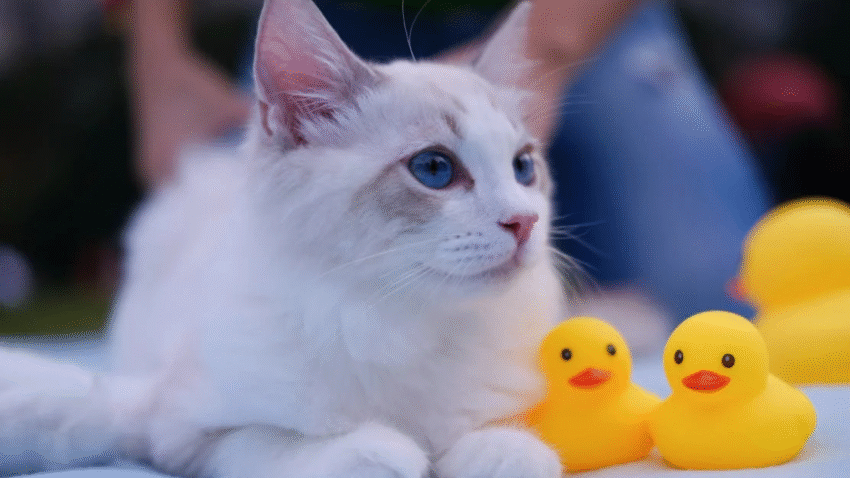Introduction
Giving your cat a treat now and then is one of the best parts of being a pet parent — but are you doing it too often? Overfeeding treats can lead to weight gain, digestive issues, and even behavioral problems. In this guide, you’ll learn how to use treats without overfeeding your cat. We’ll cover healthy portioning, smart treat choices, and training techniques that keep your cat happy, healthy, and in shape.
Why Smart Treating Matters for Cats
Treats can be a great way to bond with your cat, encourage good behavior, or provide enrichment — but they should never replace a balanced diet. Just a few extra calories a day can lead to obesity over time, especially in indoor or low-activity cats.
The key is to use treats intentionally and in moderation. When used properly, treats:
- Reinforce positive behavior
- Reduce stress during training or grooming
- Add variety to your cat’s routine
But too many, or the wrong kind, can quickly backfire.
Step-by-Step Guide to Using Treats the Right Way
1. Follow the 10% Rule
Treats should make up no more than 10% of your cat’s daily caloric intake. For most adult cats, this means around 20–30 calories per day in treats (depending on size and activity level).
How to estimate:
- Check the label of your cat’s treats for calories per serving.
- If unclear, consult your vet for daily calorie needs and treat limits.
2. Break Treats Into Smaller Pieces
Your cat doesn’t need a full-size treat every time. Break larger treats into halves or quarters to stretch them further while still offering the same reward. Cats often care more about the act of getting a treat than the size of it.
3. Use Treats for Training Only
Instead of handing out treats randomly, reserve them for:
- Positive reinforcement during training
- Rewarding calm behavior during grooming
- Luring your cat into a carrier or new environment
This keeps treats meaningful and purposeful, not habitual.
4. Offer Low-Calorie or Natural Treats
Choose healthier options like:
- Freeze-dried chicken or salmon
- Single-ingredient treats
- Vet-recommended dental chews
Avoid treats with artificial additives, sugars, or high fat content. Look for treats specifically labeled as “low calorie” or “for weight management.”
5. Use Play and Praise as Alternatives
Not every reward needs to be edible. Mix in:
- Verbal praise (“Good kitty!”)
- Head scratches or brushing
- Interactive playtime
This keeps your cat mentally stimulated and reduces dependency on food as the only reward.
Common Mistakes to Avoid
1. Giving Treats Too Frequently
Giving treats several times a day outside of training can easily pile on unnecessary calories. Stick to a set number of treat sessions (1–2 per day is ideal).
2. Using Human Food as Treats
Foods like cheese, deli meats, or milk can upset your cat’s stomach and contribute to weight gain. Human snacks are often too rich for feline digestion.
3. Ignoring Weight Gain
A few extra pounds might not seem like a lot, but in cats, it can lead to serious health problems like diabetes, joint pain, and heart disease. Monitor your cat’s weight monthly.
4. Letting Treats Replace Meals
Treats are supplements, not substitutes. Your cat should still be getting a full, nutritionally balanced diet of high-quality cat food.
5. Feeding From the Table
Giving your cat treats or scraps during your meals encourages begging behavior and unhealthy eating patterns. Always feed treats from their bowl or hand, not the table.
Extra Tips & Recommendations
1. Create a Treat Budget
Measure out your cat’s daily treat allowance in the morning. Put it in a small container, and only offer treats from that stash throughout the day. Once it’s gone, no more treats until tomorrow.
2. Make Your Own Healthy Treats
Homemade treats can be both healthy and fun. Try baking small, tuna-based treats or dehydrating chicken. Just ensure you follow cat-safe recipes with no added salt, onion, or garlic.
3. Use Puzzle Toys or Treat Balls
Instead of handing over treats, place them in treat-dispensing toys or puzzles. This encourages mental stimulation and slows down eating — great for cats who tend to gobble treats quickly.
4. Track Treats in a Food Diary
Keep a simple log of what and how much your cat eats each day, including treats. This helps you stay aware and make adjustments as needed.
5. Involve Your Vet
Discuss your cat’s treat habits at annual checkups. Your vet can recommend appropriate treats for your cat’s weight, age, and health conditions (like kidney or urinary issues).
Conclusion
Treats can be a great tool for bonding, training, and rewarding your cat — as long as they’re used in moderation. By following the 10% rule, offering healthy options, and making treats part of a balanced routine, you’ll keep your cat purring without packing on extra pounds.
🐾 Treats should be a joy — not a health risk. Give with love, but give wisely.
